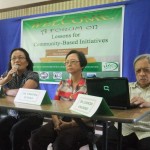A newly formed network of NGOs involved in disaster preparedness, rehabilitation and recovery criticized the government’s failure to provide decent shelter for survivors of supertyphoon Yolanda (international name Haiyan).
Citing a report of the Office of the Presidential Assistant for Rehabilitation and Recovery (OPARR), only 364 housing units have been completed by the government in Tacloban and Tanauan, Leyte. According to the Department of Social Welfare and Development in Eastern Visayas (DSWD-8), more than 20,000 individuals still live in temporary bunkhouses in Samar, Leyte, and Eastern Samar provinces.
Independent think-tank Ibon Foundation estimated that 250,000 families or 1.3 million individuals are still living in uncertain or inadequate homes such as in evacuation centers, tent cities, bunkhouses and those who partially rebuilt their homes in the government-declared “no-build” areas.
The Climate Change Network for Community-Based Initiatives (CCNCI) noted that the bunkhouses built by government are made of substandard materials, cramped and unsafe.
Suyin Jamoralin, CCNI convenor, said, “One year after, thousands of our kababayans in Yolanda-hit areas find it difficult to recover from the tragedy, receiving little or no aid from government. They remain insecure in their temporary shelter and have no means for sustainable livelihood.”
A research by the Center for Environmental Concerns (CEC) in the Eastern and Western Visayas regions revealed that survivors received little assistance from government and they relied on local and international NGOs for support. The CEC, one of the member organizations of the CCNI, conducted the field research in October in the municipalities of Calbiga and Marabut, both in Samar; Tanauan and Tacloban City in Leyte; and Estancia, Iloilo.
In terms of housing, the survivors in these municipalities, except for Barangay 37 in Tacloban City, have not been offered relocation. However, the two relocation sites offered by the local government– barangay 37-A (Palanog Resettlement Area) and Tacloban North in the northern barangay of Sto. Niño — are hazardous areas. Hazard maps of Tacloban show that Brgy 37-A stands on a fault line and is a very steep landslide area with 40 to 60% susceptibility. The Tacloban North site, meanwhile, is only 250 meters from the city dumpsite and is exposed to health and safety risks.
Government reports that only some 215,000 families have been given livelihood support through its short-term ‘Cash for Building Livelihood Assets.’ The distribution of seedlings and other farm inputs was limited to lowland farms.
A survey by Ibon Foundation with 1,094 respondents in six Eastern Visayas provinces shows that 8 out of 10 families earn less than P5,000 on the average every month.
Jamoralin, also executive director of the Citizens’ Disaster Response Center (CDRC), said both the national and local government must provide substantial assistance to the survivors of Yolanda.
Jamoralin said that instead of unsafe bunkhouses, survivors should be provided permanent houses that are typhoon and earthquake resistant. The CDRC, for one, with the help of international NGOs, is in the process of building 300 housing units that are resistant to typhoons and earthquake in the municipalities of Jaro and San Isidro, Leyte.
“There is no other way but to build back better,” Jamoralin said. “The government must face the reality of climate change. Instead of providing short-term, band-aid solutions, it must address its impacts in a comprehensive manner.”
*CCNCI is composed mainly of four national networks that are engaged in people-oriented development programs and come from varying disciplines and expertise, the Center for Environmental Concerns (CEC), Citizens’ Disaster Response Center (CDRC), Philippine Network for Food Security Programs (PNFSP) and the Advocates for Community Health. Regional and provincial NGOs such as Kaduami, Center for Development Programs in the Cordillera (CDPC), Community Empowerment Resource Network (CERNET), Farmers Development Center (FARDEC), Tuburan, IFI Visayas-Mindanao Regional Office for Development (IFI-VIMROD), Cordillera Women’s Education Action Reseach Center (CWEARC) and Integrated Development Program for Indigenous People (IDPIP) are also members of the network.


Leave a Reply